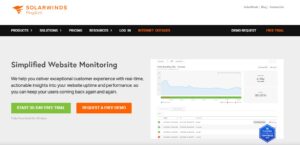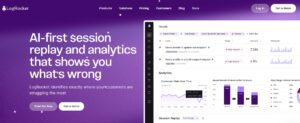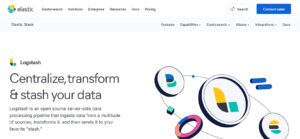HyperDX offers a lightweight, open-source observability stack built on ClickHouse and OpenTelemetry. While it’s praised for session replay and dev-friendly design, it lacks smart sampling, full compliance, and mature feature depth. As observability spending accelerates—projected to hit $6.1B by 203, expanding at a 15.9% CAGR—teams now demand deeper visibility, cost control, and enterprise-ready features. HyperDX doesn’t fully deliver.
CubeAPM is the top alternative to Zenoss, offering an OpenTelemetry-native observability platform with full MELT coverage (APM, logs, infrastructure, synthetics, and RUM) on a high-speed backend. With 800 + integrations, smart sampling, and no egress costs, it helps organisations cut costs by 60-80%.
In this article, we’ll break down the top HyperDX alternatives in 2025 across categories like feature depth, deployment flexibility, pricing transparency, OTEL compatibility, and support experience, starting with CubeAPM.
Table of Contents
ToggleTop 7 HyperDX Alternatives
- CubeAPM
- Dynatrace
- Datadog
- Coralogix
- New Relic
- AWS CloudWatch
- SolarWinds
Why Look for HyperDX Alternatives
1. Limited Advanced Features
HyperDX excels in unifying MELT (Metrics, Events, Logs, Traces) data but lacks explicit support for synthetic monitoring, a critical feature for proactive performance testing. Enterprises needing AI-driven anomaly detection or advanced analytics, as offered by competitors like Datadog or Dynatrace, may find HyperDX’s feature set insufficient for complex use cases.
2. Occasional UI Issues
Users on G2 report “occasional UI bugs,” though these are minor and quickly resolved. For teams prioritizing a flawless user experience, these glitches could disrupt workflows, especially in high-pressure DevOps environments.
As this user notes:
“occasional ui bugs, but nothing serious, and they always fix them super fast” (G2)
3. Community-Driven Support
HyperDX’s reliance on community support through GitHub and Slack, while responsive, may not meet the needs of enterprises requiring dedicated, SLA-backed support. Larger organizations often prefer platforms with 24/7 customer service or premium support tiers, which HyperDX currently lacks.
4. Scalability Challenges:
While HyperDX’s ClickHouse backend handles large telemetry volumes efficiently, self-hosted deployments can require significant expertise for tuning and resource allocation. Teams managing massive datasets may encounter performance bottlenecks, prompting them to seek more scalable solutions.
5. Compliance and Enterprise Needs
HyperDX’s open-source model is cost-effective but may not fully address compliance requirements like HIPAA or GDPR, which are critical for industries such as healthcare or finance. Competitors with robust compliance certifications often appeal to these sectors.
Criteria for Suggesting HyperDX Alternatives
1. OpenTelemetry-Native Support
We focused on platforms that seamlessly integrate OpenTelemetry (OTEL) without requiring proprietary wrappers. This ensures a smooth migration, long-term compatibility with future updates, and the flexibility to create a custom observability pipeline.
2. Unified MELT Stack Coverage
Comprehensive observability entails capturing Metrics, Events, Logs, and Traces, ideally supplemented with Real User Monitoring (RUM), synthetic monitoring, and error tracking. We prioritized platforms that natively support these features without relying on additional integrations or third-party tools.
3. Data Residency Control & Self-Hosting
For industries with strict compliance needs, having control over data residency through self-hosting or cloud-local deployment is essential. Platforms like CubeAPM allow full control over data storage within your self-hosted environment, eliminating egress costs and potential compliance risks, unlike Datadog’s default public cloud configuration.
4. Smart Sampling & Cost Efficiency
Context-aware sampling, such as prioritizing traces based on latency or errors, is crucial for minimizing ingestion costs. CubeAPM excels in this area, providing 60–80% cost savings while maintaining higher signal quality.
5. Transparent Pricing Model
We avoided platforms with unclear pricing structures or hidden charges. CubeAPM offers a straightforward $0.15/GB flat rate with no additional fees for users or hosts, ensuring predictable and scalable observability costs.
- For example:
CubeAPM: 10 TB/month = $1,500/month
HyperDX: Similar usage could cost over $4,500/month after including synthetic checks, traces, logs, and transfer fees. - Support Experience & Developer Friendliness
We sought platforms with prompt, human support—ideally via Slack or chat—along with intuitive dashboards and quick setup times. CubeAPM delivers with a 1-hour onboarding process, direct Slack access to engineers, and dashboards that are easy to use right out of the box.
HyperDX Overview
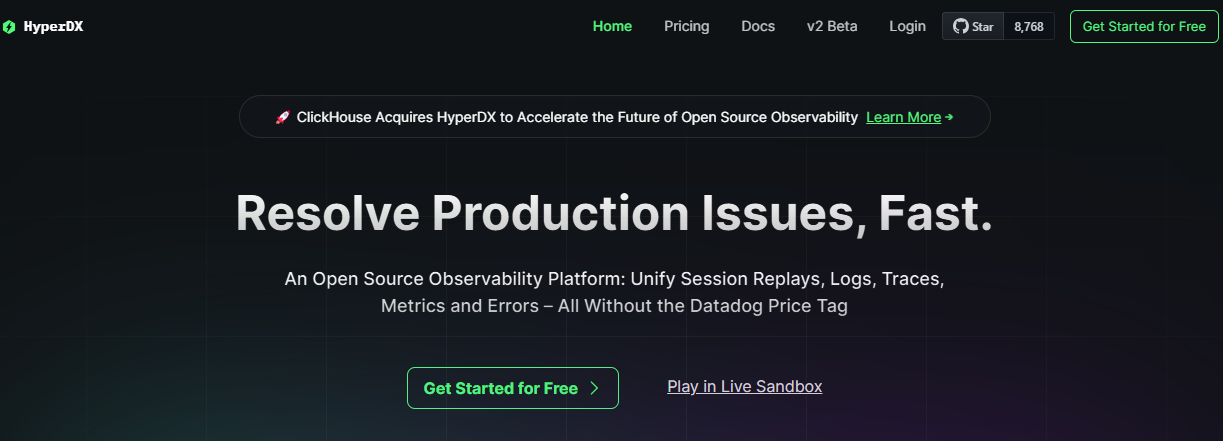
Known for
HyperDX is known as a developer-centric, open-source observability platform built on ClickHouse and OpenTelemetry. It’s designed to help engineering teams debug faster by unifying logs, traces, metrics, session replays, and errors in a single, easy-to-use interface—without the high cost of legacy vendors.
Standout Features
- Session Replay + Logs/Traces Correlation
- Log Pattern Clustering
- ClickHouse Backend
- Chart Builder
Key Features
- Native OpenTelemetry support for traces, logs, and metrics
- Ingest once, query everywhere design for full MELT visibility
- Session replays tied to logs and distributed traces
- Full-text log search with native JSON parsing
- Docker and Kubernetes deployment options
- Alerting and dashboards with customizable retention
Pros
- Built from the ground up with native OpenTelemetry support
- Offers unified observability: logs, traces, metrics, and session replay
- Open-source and self-hostable with Docker/Kubernetes deployment
- Transparent, usage-based pricing without seat or host licensing
- Fast and intuitive UI for engineers and dev-centric teams
- Lightweight ClickHouse backend enables affordable ingestion at scale
- Good support via GitHub, Discord, and active open-source community
Cons
- No native support for RUM, synthetic monitoring, or SLO dashboards
- Alerting lacks advanced routing, deduplication, and escalation workflows
- UI can be buggy or limited for power users in large-scale setups
- No built-in tail-based or intelligent sampling strategies
- Platform maturity lags behind enterprise vendors in compliance and integrations
- Limited official support for .NET, GCP, and some legacy stacks
Best For
HyperDX is ideal for modern dev teams, startups, or SMBs looking for a fast, cost-effective observability stack that supports OpenTelemetry out of the box. It’s best suited for teams comfortable with open-source tooling and self-hosting or those trying to avoid expensive per-seat enterprise tools.
Pricing & Customer Reviews
- Free Tier: Up to 3 GB/month with 3-day retention for a single user
- Starter Plan: $20/month includes 50 GB/month and 30-day retention
- Additional Ingestion: ~$0.40/GB overage; no extra fees for users or hosts
- Enterprise Plan: Custom options with SSO, extended retention, and larger volume discounts
G2 rating of : 4.5/5
Users praising its intuitive experience, OpenTelemetry-native design, and affordability. While still maturing in some areas, it’s seen as a rising open-source alternative to heavyweights like Datadog and New Relic.
Top 7 HyperDX Alternatives
1. CubeAPM Overview
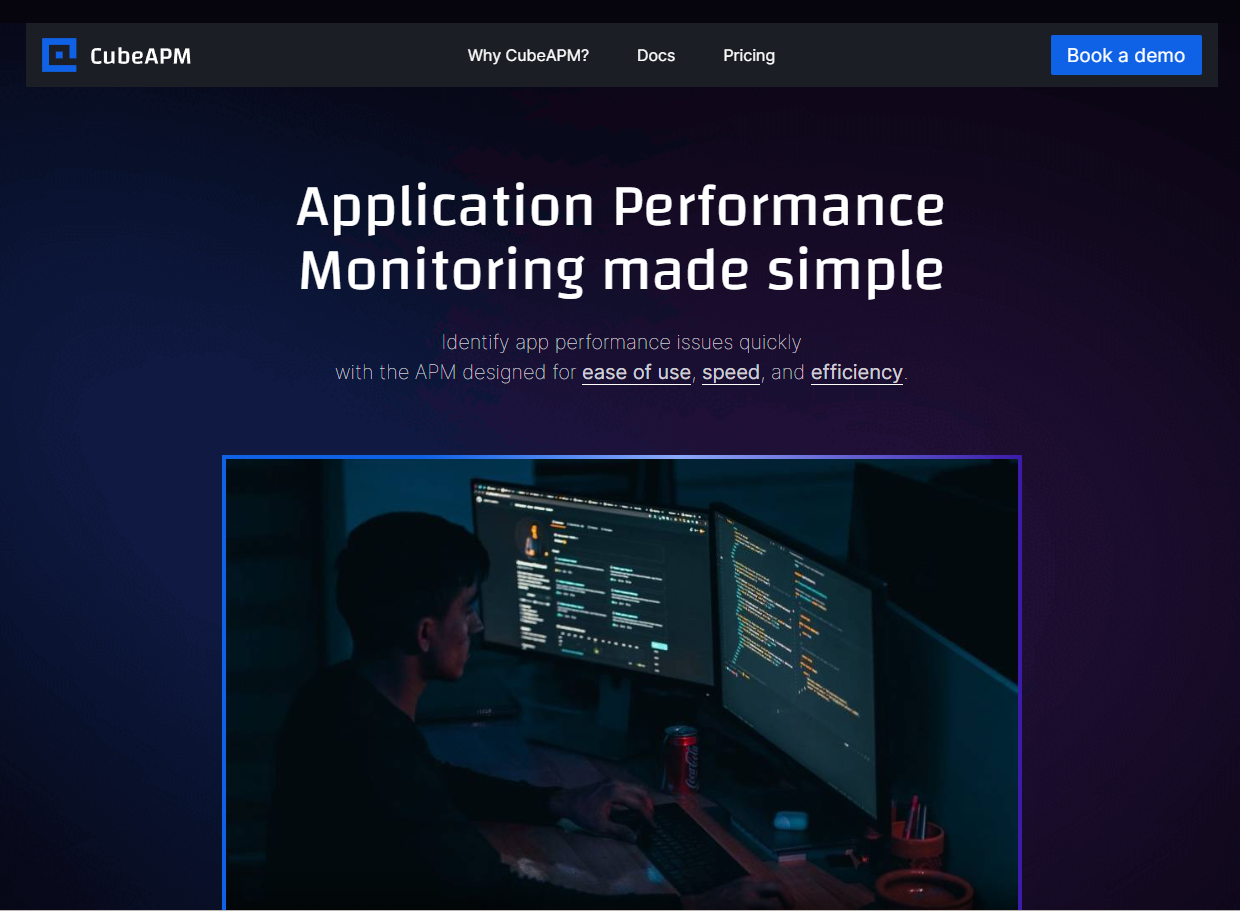
Known for
CubeAPM is a modern observability platform engineered for OpenTelemetry-native data ingestion, advanced sampling, and compliance-conscious deployments. It delivers real-time insights across the entire MELT stack—metrics, events, logs, and traces—while offering performance and cost advantages over legacy vendors like SolarWinds or AppDynamics.
Key Features
- Smart Sampling Engine
- Full MELT Support
- OpenTelemetry & Prometheus Native
- Compliance-Ready Deployment
Standout Features
- Consistently 60–80% lower total cost than tools like Datadog and New Relic
- Unlimited users with no license gating
- On-prem deployment for regulated industries
- Blazing-fast dashboards built for high-resolution, real-time analysis
- Slack-based support with <1-minute engineer response times
Pros
- Built natively on OpenTelemetry
- Efficient tail-based smart sampling reduces data bloat
- Unified view of all observability signals in one interface
- High performance at startup-friendly pricing
- Enterprise-grade deployment options for compliance teams
- 800+ integrations available
Cons
- Primarily for teams comfortable with self-hosting or private cloud
- Focused solely on observability—not a security or ITSM platform
Best For
- DevOps, platform engineering, and SRE teams scaling observability across services
- Regulated industries needing self-hosted, egress-free telemetry pipelines
- Organizations aiming to control costs while adopting OTEL at scale
Pricing & Customer Reviews
- Pricing: $0.15/GB ingestion; no user or host fees
- Customer Feedback: 4.7/5 (based on pilot programs and Slack support feedback)
Users consistently praise its speed, simple pricing, and responsive support from core engineers.
CubeAPM vs HyperDX
While both CubeAPM and HyperDX embrace OpenTelemetry and cost-efficiency, CubeAPM offers a more advanced sampling model, full MELT stack coverage (including RUM and synthetics), and enterprise-friendly deployment options. HyperDX is lightweight and open-source, but CubeAPM stands out for its smart sampling, compliance-grade hosting, and broader feature set—making it a stronger fit for production-scale environments.
2. Dynatrace Overview
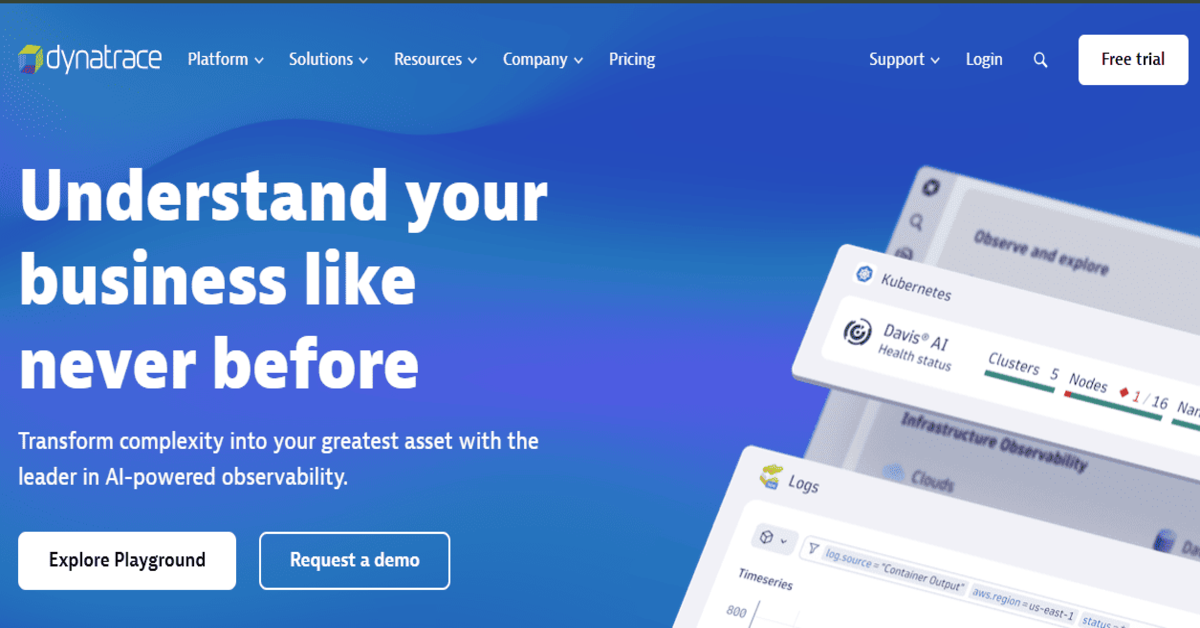
Known for
Dynatrace is an enterprise-grade observability and automation platform tailored for large-scale, cloud-native, and hybrid environments. It’s especially recognized for its Davis AI engine, which powers anomaly detection, root cause analysis, and performance optimization with minimal manual input.
Key Features
- Davis AI Engine
- End-to-End Monitoring
- Deep Code-Level Tracing
- Auto-Instrumentation
- Cloud-Native Compatibility
Standout Features
- AI-powered anomaly detection and diagnostics
- Automated service discovery with zero config
- KPI tracking and SLO-based alerting
- Built-in application security monitoring for vulnerability detection
Pros
- Exceptionally strong for large-scale environments
- Accurate and automated root cause analysis
- Minimal setup required with auto-instrumentation
- Deep visibility into application and service dependencies
- Includes RUM, synthetics, and security in one stack
Cons
- High cost—based on host hours, features, and data volume
- Limited OpenTelemetry-native support; uses proprietary agents
- Self-hosting is possible but rarely adopted due to complexity
- Rigid UI compared to more developer-friendly tools
- Can be overkill for small to mid-sized teams
Best For
- Large enterprises operating complex microservices architectures
- DevOps teams that want AI-assisted diagnostics and automation
- Organizations with the budget for premium tooling and support
Pricing & Customer Reviews
- Pricing: Starts around $0.08/hour per 8 GiB host (~$57.60/host/month), with additional charges for modules and ingest
- G2 Rating: 4.4/5
Users appreciate the automation and AI features but often cite high costs, complexity, and weaker OTEL support as key concerns.
Dynatrace vs HyperDX
Dynatrace offers enterprise-grade automation, deep diagnostics, and robust cloud integrations, but at a steep cost and with a preference for proprietary agents over OpenTelemetry. HyperDX, in contrast, is open-source, OTEL-native, and more accessible for smaller teams. While Dynatrace is better suited for Fortune 500 deployments, HyperDX is ideal for developer-led teams seeking flexibility and affordability.
3. Datadog Overview

Known for
Datadog is a cloud-native observability platform known for its wide-ranging integrations and unified view of infrastructure, application, and user experience monitoring. It’s a go-to solution for DevOps teams needing fast time-to-insight across distributed cloud environments.
Key Features
- Infrastructure Monitoring
- Application Performance Monitoring (APM)
- Log Management
- Security and Compliance Monitoring
- RUM & Synthetics
Standout Features
- Over+ 900 native integrations with CI/CD, cloud, and messaging tools
- AI-based anomaly detection via Watchdog
- Unified dashboards for metrics, traces, and logs
- SLO tracking and customizable service maps
Pros
- All-in-one platform for logs, traces, metrics, RUM, and security
- Huge integration ecosystem and fast onboarding
- Built-in alerting and anomaly detection with intelligent tuning
- Real-time visibility across global infrastructure
Cons
- Expensive and unpredictable pricing as usage scales
- Relies on probabilistic sampling (e.g., 1% trace capture)
- Opaque billing structure with multiple feature-specific charges
- No support for self-hosting or private cloud deployment
- Limited native OpenTelemetry visualization and sampling control
Best For
- Mid-to-large cloud-native organizations that want a managed, integrated solution
- Teams prioritizing ease of setup and broad ecosystem support
- Companies willing to trade pricing flexibility for vendor convenience
Pricing & Customer Reviews
-
Pricing:
-
APM: From $31/host/month
-
Logs: $0.10/GB + $1.70/million log events (15-day retention)
-
Infra: From $15/host/month
-
-
G2 Rating: 4.4/5
Customers like the rich integrations and polished UI but often express frustration over unexpected charges, data sampling limits, and lack of OTEL-native flexibility.
Datadog vs HyperDX
Datadog is more mature and feature-rich than HyperDX, but also far more expensive and rigid. It lacks native self-hosting, smart sampling, or OpenTelemetry-first design. HyperDX, while lighter in enterprise capabilities, offers cost transparency, OTEL-native ingestion, and open-source deployment—making it a more developer-friendly and budget-conscious choice for growing teams.
4. Coralogix Overview
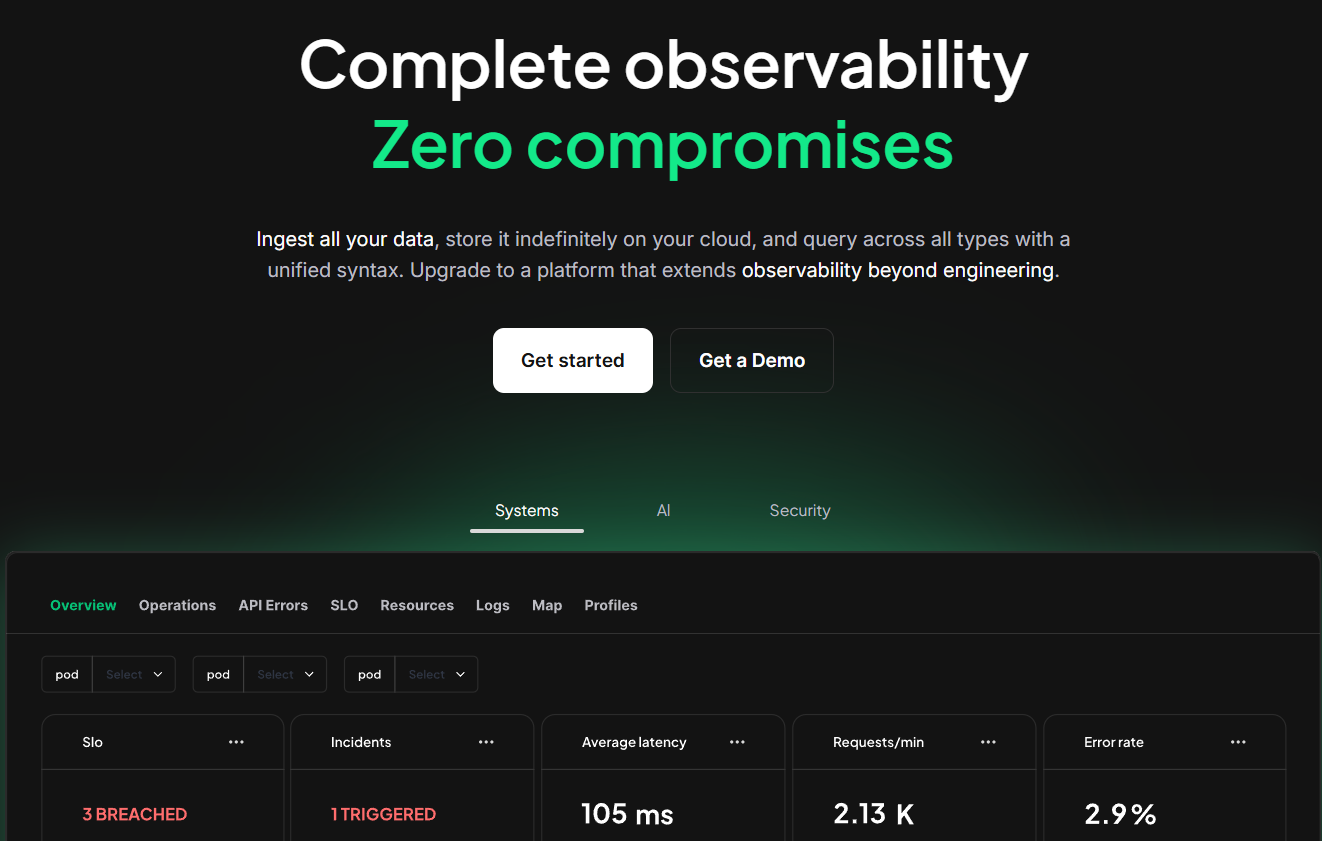
Known for
Coralogix is a log-centric observability platform built for engineering teams that require granular control over log routing, indexing, and storage costs. It’s especially popular in environments with large-scale log ingestion, CI/CD pipelines, or compliance-driven telemetry workflows, thanks to its stream-first architecture and archival flexibility.
Standout Features
- Streama™ Architecture: Separates ingestion from indexing
- Customer-Controlled Archival: Long-term telemetry is archived directly to the customer’s cloud
- CI/CD and Security Integrations: Connects seamlessly with GitHub, Jenkins, and SIEM tools for release monitoring
Key Features
- Real-Time Log Processing
- Metrics and Traces via OTEL
- ML-Powered Alerts
- Indexing & Routing Rules
- GitOps-Friendly Design
Pros
- Highly customizable log routing and storage control
- Supports OpenTelemetry and Prometheus for trace and metric ingestion
- Strong integrations for CI/CD, security monitoring, and auditing
- Usage-based pricing with lower long-term storage costs via customer-controlled archives
- Ideal for cost-conscious, log-heavy environments
Cons
- Not full-stack—lacks native support for RUM, synthetics, or deep APM features
- No smart or tail-based sampling for traces
- Compliance risks due to temporary Coralogix storage before archival
- Double billing potential due to cloud egress + storage fees
- Complex initial setup; Streama routing and enrichment require tuning
Best For
DevOps and engineering teams that handle high log volumes, need custom routing for compliance or auditing, and value indexing flexibility. It’s especially useful for organizations running CI/CD workflows, log-based security visibility, or structured log pipelines.
Pricing & Customer Reviews
- Pricing: Starts around $245.55/month (three-tier model) with pay-as-you-go options. Ingested data routed to user-managed cold storage minimizes vendor retention costs—but can incur egress fees.
- G2 Rating: 4.6 / 5
Customers highlight Coralogix’s log customization, cost control, and strong alerting, but flag its learning curve, incomplete observability coverage, and hidden network costs at scale.
Coralogix vs HyperDX
Coralogix provides powerful log lifecycle control, CI/CD integrations, and storage optimization that outperform HyperDX in log-heavy scenarios. However, it lacks full-stack capabilities, contextual trace sampling, and ease of setup. HyperDX offers a more balanced, developer-friendly experience with session replay, native OTEL support, and simpler deployment—making it ideal for teams focused on fast debugging and lower complexity.
5. New Relic Overview
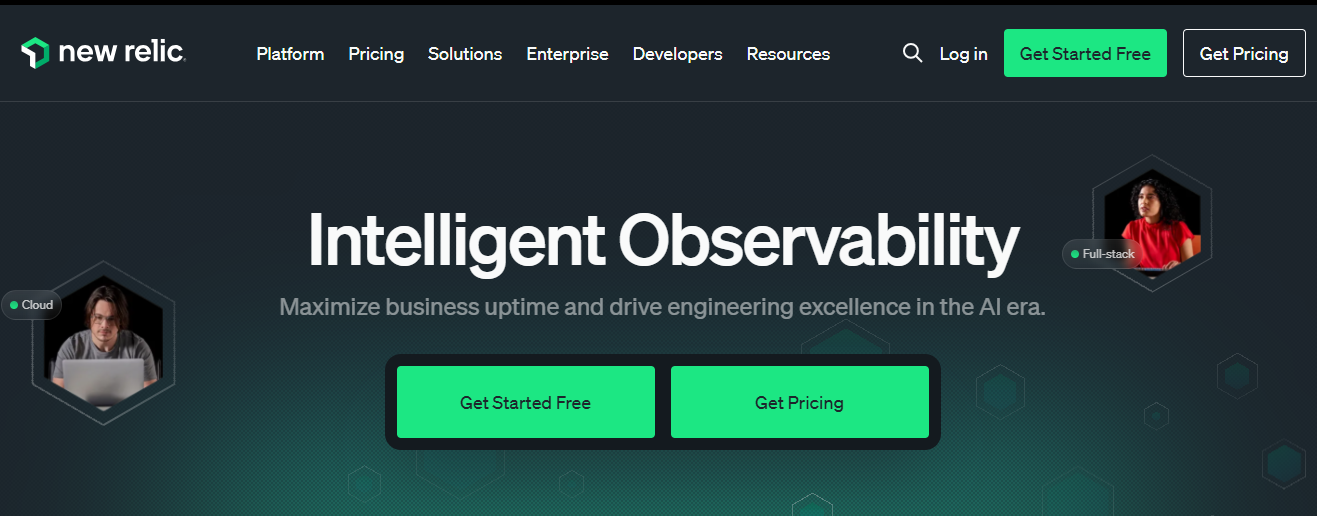
Known for
New Relic is a full-stack observability platform that combines APM, infrastructure monitoring, logs, real user monitoring (RUM), synthetic checks, and mobile telemetry in a single interface. Its Telemetry Data Platform (TDP) and proprietary NRQL query language make it a strong fit for teams looking to analyze large volumes of telemetry data quickly and centrally.
Standout Features
- Telemetry Data Platform (TDP): Aggregates data from OpenTelemetry, Prometheus, and New Relic
- NRQL Dashboards: Allows real-time queries and custom visualizations
- RUM & Mobile Monitoring: Tracks frontend session behavior
- Synthetics & SLOs: Built-in tools for uptime checks, synthetic journeys
- Auto-Instrumentation & Integrations: Supports auto-instrumentation for common frameworks
Key Features
- End-to-end MELT observability (metrics, events, logs, traces)
- RUM, mobile telemetry, and browser monitoring
- Alerting with anomaly detection and SLO support
- Prebuilt dashboards for popular environments
- Data ingestion from multiple telemetry sources
Pros
- Unified interface covering infrastructure to frontend
- Supports OpenTelemetry and Prometheus data pipelines
- Fast setup with auto-instrumentation agents
- Powerful dashboards and alerting customization
- Extensive documentation and mature ecosystem
Cons
- High cost due to per-user licenses and data ingestion fees
- Full-access user licenses can reach $400/user/month
- Only available as SaaS—no hybrid or self-hosted options
- Smart sampling and OTEL-native workflows are limited
- Data residency and compliance control is minimal
Best For
Mid-to-large organizations that want fast deployment, comprehensive dashboards, and out-of-the-box telemetry coverage. Well-suited for teams working with mixed workloads (web, mobile, infra) and prioritizing ease of onboarding.
Pricing & Customer Reviews
- Pricing:
- Free tier available
- Ingestion: ~$0.30–$0.35/GB
- Full-access user: ~$400/user/month
- G2 Rating: 4.4 / 5
Customers appreciate New Relic’s unified experience and quick time-to-value, but frequently cite concerns about cost complexity, vendor lock-in, and limited control over data hosting.
New Relic vs HyperDX
New Relic delivers a highly polished observability experience with mature frontend monitoring, NRQL dashboards, and strong integrations—but at a steep cost and without deployment flexibility. HyperDX, while lighter in features, offers full OTEL-native ingestion, session replay, and a developer-friendly open-source model. For budget-conscious teams or those needing self-hosting, HyperDX offers more control and simplicity than New Relic’s SaaS-only stack.
6. Amazon CloudWatch

Known for:
Amazon CloudWatch is AWS’s native observability service used to monitor logs, metrics, alarms, and events across cloud resources like EC2, Lambda, ECS, and RDS. It is the default choice for most teams operating inside AWS, with seamless integrations and automation hooks designed specifically for cloud-native environments.
Key Features:
- Metrics Collection
Gathers system and application metrics from over 70 AWS services, with support for custom metrics and namespace-based organization. - Log Aggregation & Analysis
Centralized ingestion of application and infrastructure logs, with SQL-like querying and filtering using Logs Insights. - Dashboarding
Visualizes telemetry through customizable dashboards using widgets, time-series graphs, and grouped metrics. - Alarming & Notifications
Configurable alarms based on thresholds, anomaly detection, or composite metrics that integrate with SNS, Lambda, and auto-scaling policies. - EventBridge Integration
Sends real-time events to AWS EventBridge for routing, automation, or triggering workflows across the AWS ecosystem. - Optional RUM & Synthetics
Provides Real User Monitoring and synthetic canary testing for frontend availability and experience metrics (billed separately).
Standout Features:
- Tight AWS Integration: Built-in support for telemetry from services like EC2, S3, DynamoDB, and Lambda, with no extra setup.
- Contributor Insights: Helps detect top contributors to latency spikes or error rates, such as a noisy IP or misbehaving API endpoint.
- Application Signals (APM-lite): Offers lightweight distributed tracing for some AWS-native services (e.g., Lambda, API Gateway).
- IAM-Based Access Controls: Uses AWS Identity and Access Management for fine-grained, role-based data access.
- Event-Driven Automation: Connects metrics and logs with infrastructure actions via CloudWatch alarms and EventBridge.
Pros:
- Seamless native monitoring for AWS services
- Highly scalable with strong SLAs
- IAM support for granular user/data access
- Event-driven automation capabilities
- Requires no agents for many AWS-native resources
Cons:
- Complex and fragmented pricing model (per metric, log, API call, dashboard, etc.)
- Limited dashboarding and visualization tools compared to Datadog or CubeAPM
- Steep learning curve, especially for configuring alarms or OTEL integrations
- No tail-based or smart sampling
- No self-hosting or cross-cloud observability support
Best For:
Teams deeply embedded in AWS infrastructure who require basic telemetry, alerting, and automation, but don’t need full-stack tracing, frontend replay, or OpenTelemetry-first workflows.
Pricing & Customer Feedback:
- Logs Ingestion: $0.50/GB
- Logs Storage: $0.03/GB/month
- Custom Metrics: $0.30/metric/month (first 10,000)
- Application Signals (APM-lite): Starts at $0.35/GB for first 10TB
- RUM: ~$1 per 100,000 events
- Synthetics: $0.0012/run
- G2 Rating: 4.5 / 5
- Praised For: Reliability, deep AWS integrations, automation hooks
- Criticized For: Billing complexity, sluggish UI, and limited front-end or full-stack visibility
Amazon CloudWatch vs Highlight.io (Short Comparison)
CloudWatch excels at monitoring AWS infrastructure and automating responses through alarms and EventBridge, but it falls short in frontend observability, session replay, and full-stack tracing. Highlight.io, on the other hand, delivers a stronger developer experience with built-in replay, RUM, and backend trace correlation—making it better suited for product teams focused on user-facing applications. For AWS-centric DevOps, CloudWatch is efficient; for frontend-backend visibility, Highlight.io provides better insight in a more approachable UI.
7. SolarWinds
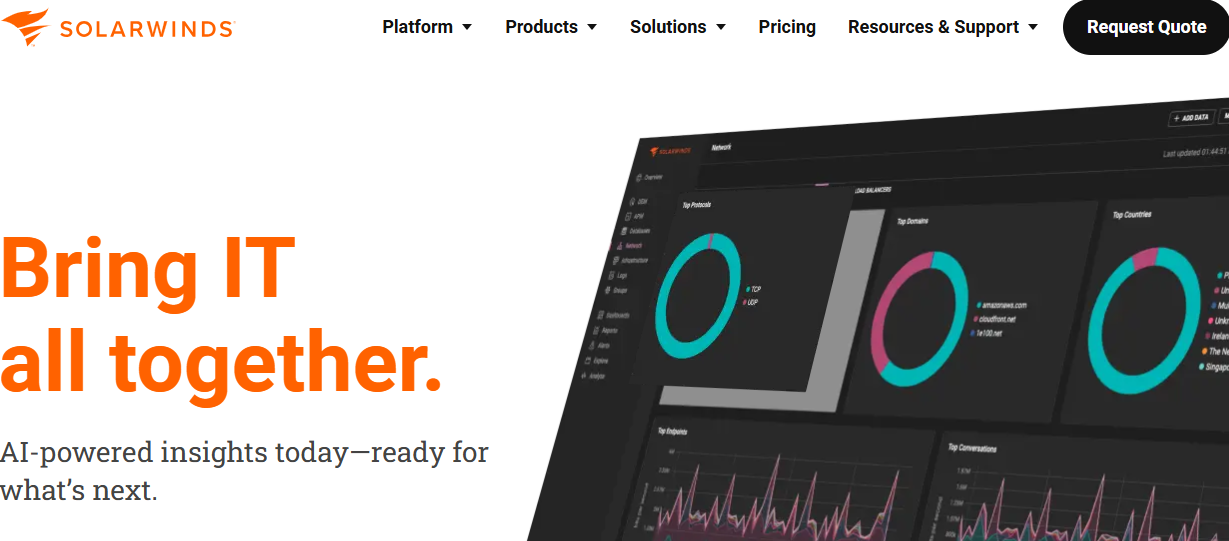
Known for:
SolarWinds is a long-standing vendor in IT monitoring and infrastructure management, recognized for its deep capabilities in network performance, server health, and database diagnostics. It’s widely used by enterprises, government agencies, and regulated industries for monitoring traditional environments through tools like Network Performance Monitor (NPM), Server & Application Monitor (SAM), and the broader SolarWinds Observability suite. Its strength lies in on-premise and hybrid infrastructure visibility, backed by decades of enterprise IT adoption.
Key Features:
- Infrastructure & Network Monitoring
Products like NPM and SAM provide detailed insight into server uptime, hardware metrics, bandwidth usage, and SNMP-based network visibility. - Database Performance Analyzer (DPA)
Specialized database monitoring for Oracle, MSSQL, and MySQL with visual query plans, wait-time analysis, and historical performance tracking. - IT Service Management (ITSM)
Includes built-in helpdesk workflows, ticket routing, SLA monitoring, and technician workload tracking through its Service Desk product. - Incident Management & Alerting
Offers centralized alert rules, role-based notifications, and integrations with tools like Microsoft Teams and Slack for real-time escalation. - Self-Hosted Deployment
Full on-premise install options for organizations requiring air-gapped, compliance-ready setups—appealing to sectors with strict data sovereignty mandates.
Standout Features:
- Modular Suite of Tools: Covers everything from monitoring and service desk to incident response and database health.
- Network-Centric Capabilities: Mature SNMP monitoring, NetFlow traffic analysis, and network topology mapping.
- Hybrid Visibility: Designed to monitor both cloud and legacy infrastructure in mixed environments.
- Custom Dashboards & Reporting: Allows threshold-based alerts, baseline comparisons, and detailed usage reporting.
- ITSM + Observability Integration: Brings asset tracking and incident workflows under the same umbrella.
Pros:
- Strong visibility into traditional IT infrastructure and hybrid networks
- Wide toolset covering monitoring, ITSM, databases, and ticketing
- On-premise deployment options for compliance and data control
- Mature SNMP and NetFlow tools for detailed network analytics
Cons:
- Pricing is modular and adds up quickly with more nodes, databases, or users
- No native OpenTelemetry support; OTEL integration requires custom mapping and lacks out-of-the-box dashboards
- High operational complexity due to fragmented tooling and interfaces
- User interface is dated and often criticized for being unintuitive
- Support response times are slow—reviewers mention multi-day delays
- No smart or tail-based sampling; noise filtering is limited
- Lingering trust concerns from the 2020 Orion breach
Best For:
Enterprises with large-scale, on-premise infrastructure, especially in regulated industries. Ideal for teams focused on asset discovery, infrastructure health, and service desk workflows rather than unified, modern observability stacks.
Pricing & Customer Feedback:
- Monitoring: $6/node/month
- Database Monitoring: $117/database/month
- ITSM: $39/technician/month
- Incident Response: $9/user/month
- Startup Estimate: ~$4,000/month for 40 nodes, 5 DBs
- Mid-size Estimate: ~$8,000/month for 150 nodes, 25 DBs, 20 techs
- G2 Rating: 4.4 / 5
- Praised for: Feature breadth, legacy infra visibility
- Criticized for: Poor UI, weak OTEL integration, high cost, slow support
SolarWinds vs Highlight.io (Short Comparison)
SolarWinds excels in traditional infrastructure and network monitoring, offering detailed visibility across servers, databases, and IT assets—especially for on-premise setups. In contrast, Highlight.io is built for modern engineering teams focused on application-layer observability with session replays, frontend insights, and backend traces. While SolarWinds is well-suited for IT operations and regulated industries, Highlight.io delivers a cleaner UX and is more relevant for dev-centric teams that prioritize full-stack debugging and cost transparency.
Conclusion: Choosing the Right HyperDX Alternative
HyperDX offers a solid open-source foundation with OTEL-native support, log-trace correlation, and affordable ingestion pricing—but it falls short when it comes to smart sampling, real user monitoring (RUM), synthetics, and enterprise-grade deployment flexibility. For fast-moving teams, it’s great for debugging—but not always sufficient for full production observability, compliance, or long-term scale.
Tools like CubeAPM, Dynatrace, Datadog, and Coralogix step in to fill those gaps—each with their own focus. CubeAPM leads with full MELT coverage, tail-based sampling, and compliance-ready hosting at a flat $0.15/GB. Others like New Relic and CloudWatch offer deeper integrations but introduce complexity, cost, or SaaS lock-in. If your team is outgrowing HyperDX’s limits, these alternatives offer a more scalable, feature-complete path forward.

